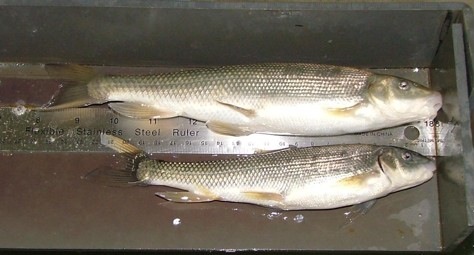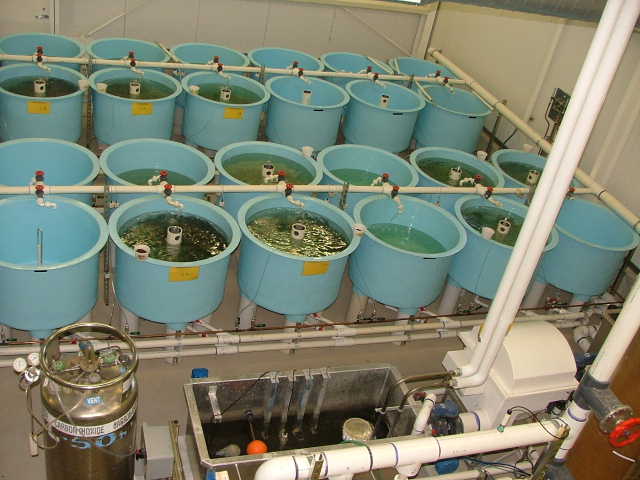≡
June Sucker Recirculation Facility
2006–2007 | 2008–2009 | Photos
The design and planning phases for a recirculating aquaculture facility were completed in 2004. PRAqua out of Nanaimo, British Columbia and JUB, out of Logan, Utah, were the engineers for this project. Bailey Construction, from Wellsville, Utah, was the general contractor. The facility will allow us to increase the water temperature to improve growth rates and survival. The goal is to annually raise 33,000 June sucker to eight inches—which is about 5,900 pounds—and stock them into Utah Lake or other refuge waters. Studies to improve production techniques will also be done in the facility.
Construction of the recirculating aquaculture facility began in October 2005 and was completed in the summer of 2006. Once the facility was ready for fish, we placed part of the 2005 young of year and several lots from the 2006 year class into the new facility.
The demands for rearing more numbers of June sucker for stocking back into Utah Lake continue. Due to a lack of warm water in our present facility, the fish grow at a rate of 3 inches per year. The 65°F degree water that these fish are being raised on is a constant stressor on the June sucker and this increases the possibility of disease outbreaks in the hatchery. The new warm water facility should help increase the growth rates and reduce the disease outbreaks on the captive June sucker.
With the help from biologist from Utah's Division of Wildlife Resources Central and Northern Region all fish stocked into Utah Lake are coded wire tagged. This is a labor intensive task that takes several days to complete. The tagging efforts have gone very well and we have had extremely low mortalities after the fish are tagged.
Growth comparisons of those fish raised in the 73°F recirculation water vs the 65°F flow through water system.
On August 25, 2006, we placed some 2005 progeny fish at 4.74 inches into 73°F water in the grow out portion of the facility. A portion of this group remained in the 65°F water, which is what the fish were raised on since initial feeding in June 2005. After being in the 73°F water for 97 days the fish grew to be 7.32 inches. This is a 2.58 inch growth increase and a daily growth of .0266 inches. In November 2005, these fish grew .97 inches, which is a daily growth of .032 inches. In comparison, over the same 97 day period, the fish that remained on the 65°F water were only 6.01 inches and this is a daily growth of only .012 inches. Just an observation, but when condition factors were taken on these fish the fins on the fish in the 73°F water looked very good, while those fish on the 65°F water had a high percentage of frayed and eroded fins.
Condition factor on above fish as of Feb. 23, 2007
| Treatment | Condition factor |
|---|---|
| Fish moved to 73°F water | .0003527 |
| Fish remaining on 65°F water | .0003485 |
Below is a photo showing the improved condition factor and growth on a typical fish being raised in 73°F water in the recirculating facility compared to 65°F water in our flow through system. The photo shows two fish from the same lot with the larger one placed into the 73°F water on Aug. 25, 2006. This photo was taken on Feb. 21, 2007.

Daily growth comparisons from various groups
| Daily growth | Water temperature | Comments |
|---|---|---|
| .011 inches | 65°F | Average of All 2005 progeny fish kept on 65°F water |
| .0235 inches | 73°F | Average of all 2005 fish after moving to 73°F water |
| .022 inches | 73°F | Average of all 2006 progeny fish placed into 73°F water |
Automatic belt feeders: In October 2007, we began evaluating automatic belt feeders purchased from Aquatic Ecosystems, Inc. The results have been very promising with excellent growth rates on those fish being raised in the grow out portion of the recirc facility. The two tables below show a growth comparison from October–December 2007 for those fish in the grow out system being fed using automatic feeders compared to hand feeding 8 times per day.
2007 automatic feeder results
| Lot number | October | November | December | Average |
|---|---|---|---|---|
| 070604LotFE08 | .039 inches | .035 inches | .032 inches | .035 inches |
| 070604LotFE09 | .032 inches | .029 inches | .029 inches | .03 inches |
| 070604LotFE17 | .036 inches | .036 inches | .03 inches | .034 inches |
| 070604LotFE10 | .032 inches | .033 inches | .025 inches | .03 inches |
| Totals | .032 inches | |||
Hand feeding 8 times per day, 2007
| Lot number | October | November | December | Average |
|---|---|---|---|---|
| 070604LotFE26 | .025 inches | .03 inches | .023 inches | .026 inches |
| 070604LotFE21 | .027 inches | .028 inches | .024 inches | .026 inches |
| 070604LotFE19 | .022 inches | .03 inches | .017 inches | .023 inches |
| 070604LotFE29 | .025 inches | .018 inches | .023 inches | .022 inches |
| 070604LotFE24 | .024 inches | .028 inches | .02 inches | .024 inches |
| 070604LotFE11 | .022 inches | .022 inches | .025 inches | .023 inches |
| Totals | .024 inches | |||
For the short period of time that we have been raising fish in the recirculating aquaculture facility, it is obvious that the fish do much better in the 73°F water. The overall health and condition of the fish are much improved and disease issues have been all but eliminated so far. Necropsies were taken to compare those fish raised on the 73°F water compared to 65°F water. The fish in the warm water had better condition factors, the fats were 3.2 in the warm water compared to 1.8 in the 65°F water and the condition of the fins in the warm water was very much improved with little if any fraying or erosion. If the growth rates continue, we should expect to get the fish to 8 inches in 11–13 months compared to 24 months with the fish being raised on 65°F water. It looks like recirculating aquaculture facilities are very promising and to help in recovery efforts more recirculating facilities may need to be built.
Progeny lots: The new facility receives larval fish from fertilized eggs taken from the AAHRC's brood stock. The eggs are hatched in the present facility and then moved to the recirculation facility when the larval fish are about 2–4 weeks old. We will need to make several crosses, as outlined in the genetics management plan, to meet the goal of stocking 33,000 fish at 8 inches annually, plus other needs for other programs as needed.
Research studies: These will be done on an annual basis as needed. Proposals for funding of research projects will be prepared as needed and funded separately. Personnel time for these projects will be charged to the interim O&M budget.
In June 2007, we began another feed trial in the early rearing portion of the new recirculation facility using progeny fish from the 2007 egg take. Five different diet types were formulated at the USFWS Bozeman Fish Technology Center. About 36,000 eggs were shipped to Bozeman and we kept the remaining portion of those eggs taken from several combined lots. The larval fish from those eggs were used in the feed study and each treatment had three replicates with 350 fish per replicate. Both facilities are rearing the fish in 73°F water. The study ran for three months and was terminated in mid September 2007. Our standard feeding protocol of initially feeding brine shrimp for two weeks and then converting over the June sucker diet, proved to be the best diet.
















